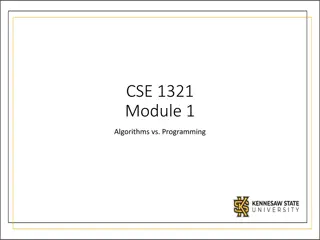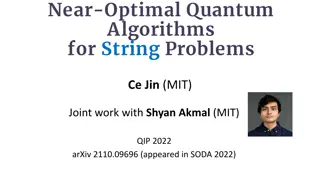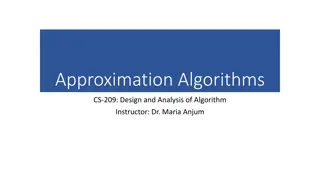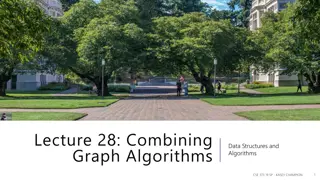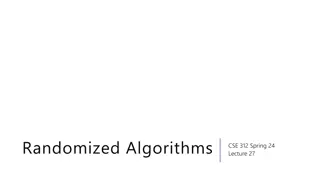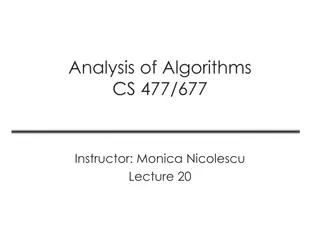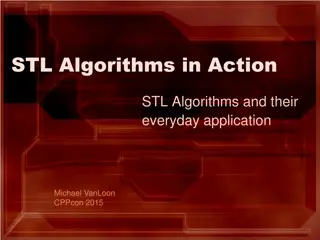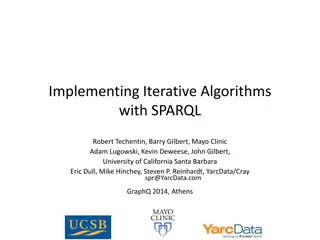Design & Analysis of Algorithms
This course, CMPT 405, delves into the intricacies of designing and analyzing algorithms. Students will explore various algorithms, their efficiencies, and optimization techniques. Topics covered include data structures, dynamic programming, graph algorithms, and more. By the end of the course, participants will have a comprehensive understanding of algorithm design principles and the ability to analyze their performance in different scenarios.
Download Presentation

Please find below an Image/Link to download the presentation.
The content on the website is provided AS IS for your information and personal use only. It may not be sold, licensed, or shared on other websites without obtaining consent from the author. Download presentation by click this link. If you encounter any issues during the download, it is possible that the publisher has removed the file from their server.
E N D
Presentation Transcript
CMPT 405 Design & Analysis of Algorithms January 19, 2022
Today 1) Kruskal s algorithm for finding minimum spanning tree 2) Karger s algorithm for finding minimum cut
Kruskals Algorithm Input: an undirected graph connected G = (V,E) with weights {ce>0 : e E} Output: a spanning tree of minimum weight 1. Set T = empty set 2. While |T| < |V|-1 do Pick an edge e E\T with minimum weight such that T {e} does not contain a cycle. Add e to T a) b) 3. Return T
Kruskals Algorithm - example a a 1 1 2 2 MST: 3 b c b c 3 2 1 1 2 8 5 4 d e f d e f 5 2 1 1 7 g h g h
Kruskals Algorithm: Correctness Lemma (the cut property): Suppose that set X of edges is a part of a minimum spanning tree. Let S be a nonempty subset of vertices, S V, such that X does not cross between S and V\S. Let e be the minimum weight edge connecting S to V\S. Then X {e} is contained in some minimum spanning tree. Proof: [exchange argument] Fix a spanning tree T* that contains the edges X, If e belongs to T*, then X {e} is contained in T*, and we are done. Suppose that e T*. Let s add e to T*. This will create a cycle in T* This means that we can remove another edge e from T* such that 1) e is an edge from S to V\S 2) But ce <= ce (because e has minimum weight) 3) Removing e turns T* into a tree again, and does not increase the weight of the tree
Kruskals Algorithm: Correctness e S y u x e z w r V\S q
Kruskals Algorithm: Correctness Theorem: Kruskal s algorithm produces a minimum spanning tree. Proof: 1) The output T is a spanning tree because T contains no cyclces T has |V|-1 edges 2) T has minimum weight. This is because Claim: In every step the edges added by the algorithm so far belong to some minimum spanning tree. Proof of claim: By induction on the steps of the algorithm. In the beginning T is empty, and the claim holds trivially. Let T be a tree so far, and consider the next added edge (v,w). Let S be the vertices reachable in T from v. Clearly v S, and w S. The edge (v,w) is the lightest edge connecting S to V\S. Therefore, but the cut property T { (v,w) } belongs to some min spanning tree
Kruskals Algorithm: Runtime Runtime: Suppose G has n=|V| vertices and m=|E| edges. Straightforward analysis: We add n-1 edges, each time looking for the lightest edge, and then run DFS/BFS to check if the edge closes a cycle. Kruskal s algorithm runs in time at most < |V| * |E| * (|V|+|E|) = O(|E|2 * |V|) Note that log(m)<2log(n) because m<n2 But we can do better: 1) We can sort the edges in O(m log(m)) time 2) Use union-find even with O(log(n)) time per operation. Hence, good data structure we can construct an MST in time O(m log(n)).
Kargers Min-Cut algorithm
Kargers Min-Cut algorithm Input: A graph G=(V,E) Output: minimum cut in G A minimum cut in G is a subset of vertices S V such that the number of edges between S and V\S is minimal. For example, min-cut(G) <= min-degree(G) Denote the number of edges between S and V\S by E(S,V\S). You have probably seen the Max-Flow Min-Cut theorem and a Max-Flow algorithm (Ford-Fulkerson or Edmonds-Karp) Today we will see a randomized algorithm for the min-cut problem.
Kargers Min-Cut algorithm Input: A connected graph G=(V,E) Output: Min-Cut(G) Algorithm: While G has more than 2 vertices do 1. Choose a random edge e E 2. Contract e Return the partition corresponding to the two remaining supernodes.
Kargers Min-Cut algorithm Example: ab abc ab a (a,b) (e,f) (ab,c) b c c c f f e e ef ef The partition is S = {a,b,c} V\S = {e,f} The cut size is E(S, V\S) = 4
Kargers Min-Cut algorithm Input: A connected graph G=(V,E) Output: Min-Cut(G) Algorithm: While G has more than 2 vertices do 1. Choose a random edge e E 2. Contract e Return the partition corresponding to the two remaining supernodes.
Kargers Min-Cut algorithm Algorithm: While G has more than 2 vertices do What is the total runtime of the algorithm? 1. Choose a random edge e E 2. Contract e Return the partition corresponding to the two remaining supernodes. Theorem: Let (S, V\S) be a partition corresponding to the minimum cut in G. Then Pr[algorithm returns this partition] >= 2/(n2-n) > 2/n2 Therefore, by repeating the algorithm t = O(n2) times and taking the best solution we can find min-cut(G). Indeed, Pr[all t repetitions fail to find a good solution] < (1 2n-2)t < e-2t/n2
Kargers Min-Cut algorithm Theorem: Let (S, V\S) be a partition corresponding to the minimum cut in G. Then Pr[algorithm returns this partition] >= 2/(n2-n) > 2/n2 Conclusion: by repeating the algorithm t = O(n2) times independently, and taking the best solution we can min-cut(G) with probability 99%. Indeed, let t = 3n2 Pr[all t repetitions fail to find a good solution] < (1 2n-2)t < e-2t/n2 = e-6 < 0.01 Q: What is the total runtime of the algorithm? Fact: (1-x)y < e-xy A: t * (time of the base algorithm) = poly(n)
Kargers Min-Cut algorithm Theorem: Let (S, V\S) be a partition corresponding to the minimum cut in G. 2 Then Pr ??????? ? ??????? ? ?? ????????? ?(? 1). Proof: Let C = E(S, V\S) be the edges in this particular min-cut. Observation 1: If the algorithm never chooses an edge in C, then it returns (S, V\S) ? ?. Pr ????? ???? ?? ??? ?? ? = 1 Observation 2: |C| <= min-deg(G) Observation 3: |E| >= min-deg(G)*n/2 ? ? 1 ??? deg(?) ??? deg ? ?/2=? 2 ?. Pr ????? ???? ?? ??? ?? ? = 1
Kargers Min-Cut algorithm Theorem: Let (S, V\S) be a partition corresponding to the minimum cut in G. 2 Then Pr ??????? ? ??????? ? ?? ????????? ?(? 1). Proof: Thus far we showed that ? ? 1 ??? deg(?) ??? deg ? ?/2=? 2 ?. Pr ????? ???? ?? ??? ?? ? = 1 After contracting the first edge, we get a graph on n-1 vertices ??? deg(? ) ??? deg ? (? 1)/2= 1 ? 1=? 3 2 ? 1. Pr ?????? ???? ?? ??? ?? ? 1 and so on. Therefore, Pr ? ? ??????? ? ? ????? ?? ???? ???? ? ? 2 ? ? 3 ? 1 ? 4 ? 2 2 4 1 2 3= ?(? 1)
Questions? Comments?




